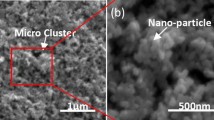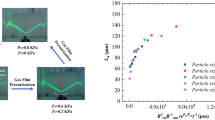Abstract
In this paper, the icephobic properties of superhydrophobic surfaces are investigated under dynamic flow conditions using a closed-loop low-temperature wind tunnel. Superhydrophobic surfaces were prepared by coating aluminum and steel substrate plates with nano-structured hydrophobic particles. The superhydrophobic plates, along with uncoated controls, were exposed to a wind tunnel air flow of 12 m/s and −7 °C with deviations of ±1 m/s and ±2.5 °C, respectively, containing micrometer-sized (∼50 μm in diameter) water droplets. The ice formation and accretion were observed by CCD cameras. Results show that the superhydrophobic coatings significantly delay ice formation and accretion even under the dynamic flow condition of highly energetic impingement of accelerated supercooled water droplets. It is found that there is a time scale for this phenomenon (delay in ice formation) which has a clear correlation with contact angle hysteresis and the length scale of the surface roughness of the superhydrophobic surface samples, being the highest for the plate with the lowest contact angle hysteresis and finest surface roughness. The results suggest that the key for designing icephobic surfaces under the hydrodynamic pressure of impinging droplets is to retain a non-wetting superhydrophobic state with low contact angle hysteresis, rather than to only have a high apparent contact angle (conventionally referred to as a “static” contact angle).








Similar content being viewed by others
References
Carré A, Mittal KL (eds) (2009) Superhydrophobic surfaces. VSP/Brill, Leiden
Neinhuis W, Barthlott C (1997) Ann Bot 79:667
Ma M, Hill RM (2006) Curr Opin Colloid Interface Sci 11:193–202
Ou J, Perot B, Rothstein JP (2004) Phys Fluids 16:4635–4643
Choi C-H, Ulmanella U, Kim J, Ho C-M, Kim C-J (2006) Phys Fluids 18:087105
Steinberger A, Cottin-Bizonne C, Kleimann P, Charliax E (2007) Nat Mater 6:665–668
Moulinet S, Bartolo D (2007) Eur Phys J E 24:251–260
Checco A, Hofmann T, DiMasi E, Black CT, Ocko BM (2010) Nano Lett 10:1354–1358
Rathgen H, Mugele F (2010) Faraday Disc 146:49–56
C. Henoch, T.N. Krupenkin, P. Kolodner, J.A. Taylor, M.S. Hodes, A.M. Lyons, C. Peguero, K.S. Breuer (2006) Turbulent drag reduction using superhydrophobic surfaces. In Proceeding of the 3rd AIAA Flow Control Conference, 5–8 June 2006, San Francisco
Schmatko T, Hervet H, Leger L (2006) Langmuir 22:6843–6850
Joseph P, Cottin-Bizonne C, Benoit J-M, Ybert C, Journet C, Tabeling P, Bocquet L (2006) Phys Rev Lett 97:156104
Choi C-H, Kim C-J (2006) Phys Rev Lett 96:066001
Kulinich SA, Farzaneh M (2009) Appl Surf Sci 255:8153–8157
Kulinich SA, Farzaneh M (2010) Cold Regions Sci Tech 65:60–64
Tourkine P, Merrer ML, Quere D (2009) Langmuir 25:7214–7216
Yina L, Xiab Q, Xuea J, Yanga S, Wanga Q, Chena Q (2010) Appl Surf Sci 256:6764–6769
Karmouch R, Ross GG (2010) J Phys Chem C 114:4063–4066
Cao L, Jones AK, Sikka VK, Wu J, Gao D (2009) Langmuir 25:12444–12448
C. Swarctz, E. Aljallis, S. Hunter, J. Simpson, C-H. Choi (2010) Characterization of superhydrophobic surfaces for anti-icing in a low-temperature wind tunnel. In Proceeding of the ASME 2010 International Mechanical Engineering Congress & Exposition, 12–18 November 2010, Vancouver, Canada
Choi C-H, Kim C-J (2009) Langmuir 25:7561–7567
Acknowledgments
This research was sponsored by the U.S. Department of Energy (DOE), Office of Electricity Delivery and Energy Reliability, Advanced Cables and Conductors Program, Contract DE-AC05-00OR22725 and DOE Award No. NFE-08-01911.
Author information
Authors and Affiliations
Corresponding author
Additional information
This article is part of the Topical Collection on Contact Angle Hysteresis
Rights and permissions
About this article
Cite this article
Sarshar, M.A., Swarctz, C., Hunter, S. et al. Effects of contact angle hysteresis on ice adhesion and growth on superhydrophobic surfaces under dynamic flow conditions. Colloid Polym Sci 291, 427–435 (2013). https://doi.org/10.1007/s00396-012-2753-4
Received:
Accepted:
Published:
Issue Date:
DOI: https://doi.org/10.1007/s00396-012-2753-4




